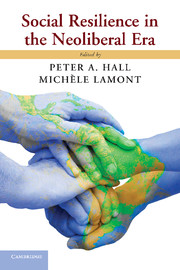Book contents
- Frontmatter
- Contents
- Contributors
- Foreword
- Prologue
- Acknowledgments
- Introduction
- Part I Neoliberalism
- Part II The Social Sources of Individual Resilience
- Part III Social Resilience on a Macro Scale
- PART IV Communities and Organizations as Sites for Social Resilience
- 9 Neoliberalism in Québec
- 10 Can Communities Succeed When States Fail Them?
- 11 Cultural Sources of Institutional Resilience
- 12 The Origins and Dynamics of Organizational Resilience
- Index
- References
12 - The Origins and Dynamics of Organizational Resilience
A Comparative Study of Two French Labor Organizations
Published online by Cambridge University Press: 05 May 2013
- Frontmatter
- Contents
- Contributors
- Foreword
- Prologue
- Acknowledgments
- Introduction
- Part I Neoliberalism
- Part II The Social Sources of Individual Resilience
- Part III Social Resilience on a Macro Scale
- PART IV Communities and Organizations as Sites for Social Resilience
- 9 Neoliberalism in Québec
- 10 Can Communities Succeed When States Fail Them?
- 11 Cultural Sources of Institutional Resilience
- 12 The Origins and Dynamics of Organizational Resilience
- Index
- References
Summary
Since the late 1990s, in the wake of John Sweeney's election as president of the American Federation of Labor-Congress of Industrial Organizations (AFL-CIO) in the United States, the study of labor revitalization has become a small industry. Although this industry (e.g., Frege and Kelly 2004; Milkman and Voss 2004; Turner 2005) has identified many external (e.g., employer hostility, unfavorable legal framework, outsourcing, neoliberalism, globalization) and internal (e.g., disconnected leadership, bureaucratic inertia, fear of change, inter-union competition) factors that can shape trade unions’ decision to engage in revitalization strategies, it has given a secondary status, if any at all, to culture. In doing so, these studies have neglected the cognitive constraints and symbolic work that underpin the diagnoses of trade unions and have thus failed to explain how labor activists come to believe that revitalization is necessary in the first place and furthermore, devise a strategy for achieving that goal.
This chapter attempts to fill this gap by comparing the political-cultural processes behind the divergent outcomes of two French labor organizations: the French Democratic Confederation of Labor (CFDT) and the General Confederation of Labor (CGT). Whereas the former reacted relatively quickly to decline and demonstrated resilience, the latter proved incapable of responding adequately to decline and drifted for a long period before it finally tried to change course. What is most puzzling in the case of the CGT is that it lost approximately 65 percent of its membership between 1977 and 1990 without acknowledging that it was undergoing a crisis and therefore without substantially attempting to take a new course. Only in the early 1990s did it finally recognize that dramatic changes were required, and it took another ten years to engage in recruitment campaigns to try to attract new members. How can we make sense of such drift? How can we explain the contrast between the CFDT and the CGT? Why has the CFDT proven more resilient than the CGT? More generally, why are some organizations more resilient than others?
- Type
- Chapter
- Information
- Social Resilience in the Neoliberal Era , pp. 346 - 376Publisher: Cambridge University PressPrint publication year: 2013
References
- 11
- Cited by



